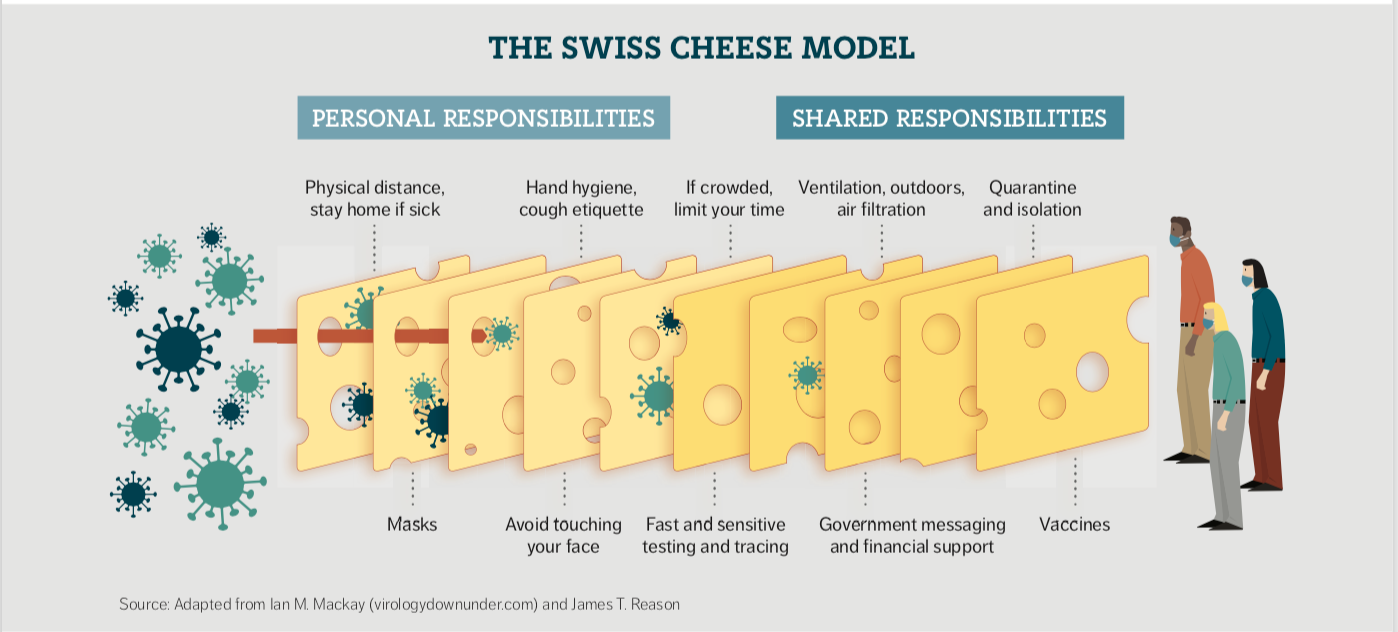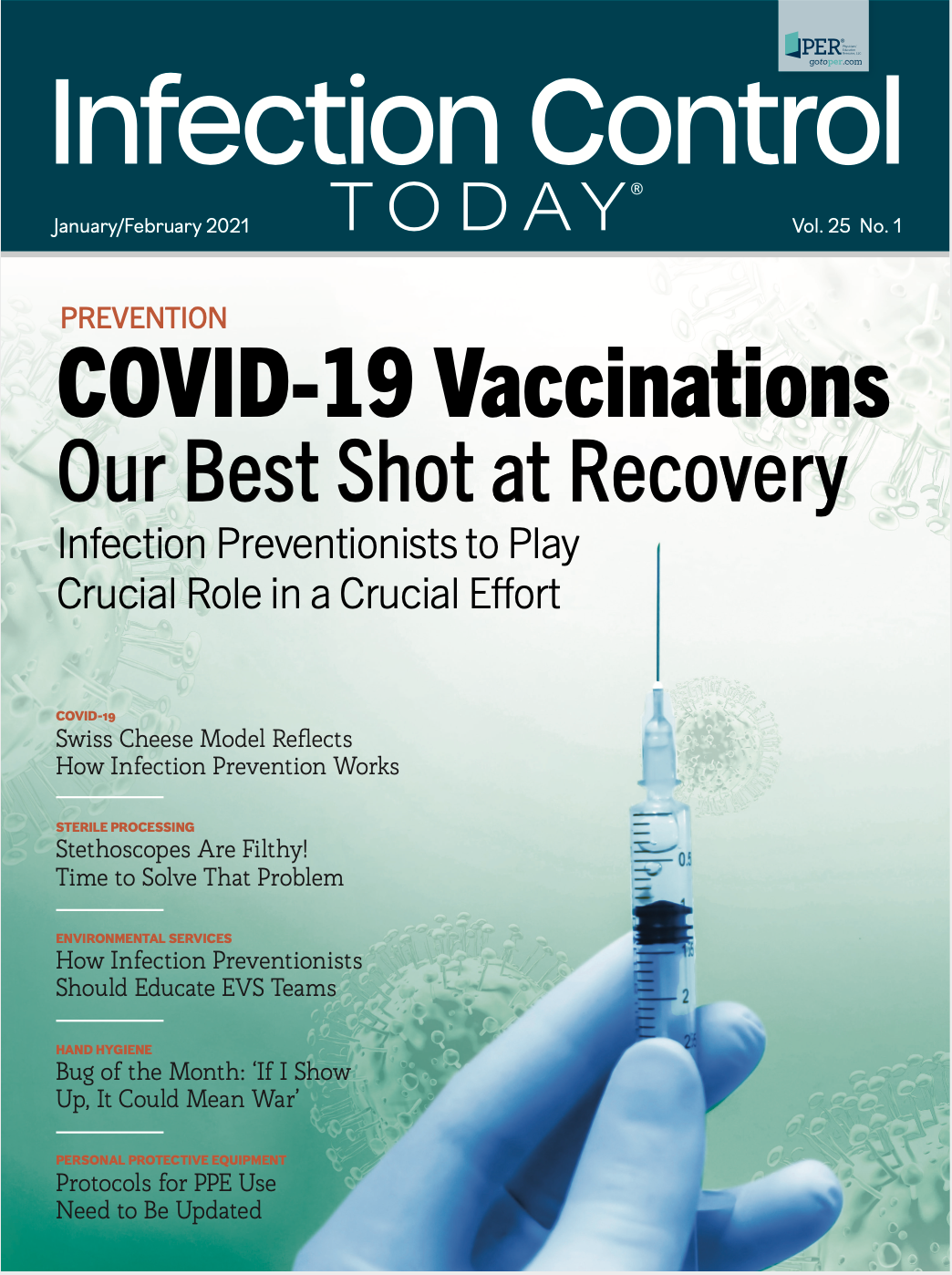Swiss Cheese Model—How Infection Prevention Really Works
In essence, infection prevention and control isn’t just one measure, like personal protective equipment (PPE), but all of these layers. Each layer is imperfect but plays a critical role in reducing risk.
The coronavirus disease 2019 (COVID-19) pandemic has taught several painful lessons. With the United States experiencing more than 200,000 cases a day, a new high of 4000 deaths a day, and the initial vaccine deployments underway, this is a pivotal time.1 As we move into the next phase of COVID-19, not only in terms of the current surge, but also in this period of vaccination for healthcare workers and essential workers, there is still a critical need for infection prevention measures against COVID-19.
Early on in the pandemic, we in healthcare were trying to piece together the right guidance to try to protect against the novel coronavirus, much of which was sure to change—from masking to the role of environmental transmission. One of the biggest mistakes we made in communicating during the pandemic was not preparing the public for the fact that guidance would likely evolve with the science. One of the largest pieces to that is that risk reduction is additive. In essence, infection prevention and control isn’t just one measure, such as personal protective equipment (PPE), but many practices and strategies taken all together. Each layer is imperfect but plays a critical role in reducing risk.
For years in harm reduction this has been called the Swiss Cheese approach but, more recently, it has been updated and harnessed. Virologist Ian Mackay, PhD, recently updated this model to address the need for defense against respiratory pathogens, such as SARS-CoV-2, the virus that causes COVID-19.2 In one succinct image, this captures what we do in infection prevention—stress the additive layers that are needed to reduce the spread of infection. From masking to government messaging and vaccines, these layers all work cohesively to reduce the risk of not only COVID-19 infection, but also transmission. Really, this is a concept we have been reinforcing and growing in the field of infection prevention—a wholistic approach to disease prevention.
Layers of Cheese
Although this layered, wholistic approach to infection prevention is not new, Mackay’s visualization of this for COVID-19 has been a welcome educational tool. The layers are broken into personal and shared responsibilities. When we apply these layers to infection prevention, there are several more revealing lessons to be learned.
For personal responsibilities, these include physical distancing and staying home if sick, masks, hand hygiene, cough etiquette, avoiding touching one’s face, and limiting time in a crowded space. For those shared responsibilities, fast and sensitive testing/tracing, ventilation/outdoors/air filtration, government messaging and financial support, quarantine and isolation, and vaccines. Many of these layers though are more telling of systemic issues within not only infection prevention, but also within healthcare.

If we break these down, there are so many critical pieces that we’ve struggled with in infection prevention and control. As roughly 1 in 5 people with COVID-19 are asymptomatic, the staying home when sick can be particularly challenging, but even more so in healthcare when we have a notoriously bad habit of working while sick.3 This also becomes increasingly important as healthcare workers can continue working, with PPE, after exposures, and with the somewhat non-specific symptoms of COVID-19, it’s easy to see how this can happen.
For infection prevention though, how can we emphasize this during our education and training of staff? The truth is that COVID-19 has emphasized the importance of workplaces allowing their employees to not only call out when sick but encouraging it. This ultimately goes back to a cultural shift that is so desperately needed in healthcare. There is a desperate need for administrative buy-in not only for infection prevention measures like cleaning and disinfection, but also for encouraging people to stay home when sick.
Double Occupancy
If we look to another layer, like crowding, this is particularly relevant in crowded emergency rooms and double-occupied patient rooms. Challenges in ensuring faster response to emergency rooms and urgent cares would require additional staffing, which is particularly hard in an industry with high turnover and an exhausted workforce. For patient rooms, we have long been moving away from double occupancy, but with COVID-19, many are forced to move to this strategy in order to handle surge capacity.
As this is an increasingly uncommon practice, this can be a wonderful teaching moment for staff. When and how can we safely put 2 patients in the same care space? Focusing on the same infections and discussing when we wouldn’t put 2 patients together goes back to the core of what infection prevention is about: education and patient safety. When we invest the time in training staff about various infections and how things like putting 2 cystic fibrosis patients together can be devastating, they have a stronger foundation of what infectious diseases are and their transmission dynamics.
Ultimately, it’s these lessons that help strengthen infection prevention in the most wholistic manner possible. This also applies to crowded spaces indoors, like breakrooms and charting rooms where people might be eating and drinking. Even if distanced, we know there is still a risk for those in such spaces for a period of time without masks. Hospital breakrooms have become a source of COVID-19 transmission and this is a prime example of how the Swiss Cheese model works. Even if we’re distanced, the indoor environment and time likely spent unmasked around others all adds up.4 Distancing helps, but it is only one piece to this puzzle, whereas masking and consideration for those indoor spaces must also be included.
Layers like quarantine and isolation are also so important to our efforts in infection prevention. Although we most commonly focus on isolation precautions within the healthcare setting, we increasingly are having to teach those exposed to COVID-19 about quarantine. What is the best way to do this for families or when patients are discharged but still require isolation? These are the lessons that clinical staff will need in science communication and the tips/tricks we’ve learned over the years in infection prevention. This is an important layer, meaning it’s that much more valuable to invest the time in helping to train staff about making those calls or teaching patients about home isolation. It’s important we give patients and their families the best chance for success when they leave the healthcare setting.
What to Add
Surely, we could spend time breaking down each layer of this model and how it plays into infection prevention inside and outside the healthcare setting. One particular question, however, is: Should there be more pieces of cheese? A few things could be added—for example, cleaning/disinfection is an important piece to prevention efforts for many infectious diseases. Although surfaces are not the primary route of transmission, cleaning and disinfection is still an important message in COVID-19 prevention. Second, mental health support that encourages people to stay home and healthcare workers to continue in their critical tasks. Harm and risk reduction require us to use careful language to not add shame or blame to actions and part of this is when we support people to stay home and not shame them for making a decision out of a need for social interaction. Let’s provide safer, more abundant options for this need that we can all appreciate right now.
The Swiss Cheese model is a wonderful representation of all that goes into infection prevention efforts. It’s not just isolation and PPE, but also the government messaging and financial support for those people to stay home. These are lessons that not only stem from our infection prevention efforts, but also directly translate to actions we should take to grow and expand our efforts, things like government messaging can also be read as administrative messaging. How supportive of your program is the hospital administrative team? How quickly are results shared from the lab to the unit? Are healthcare workers and ancillary staff encouraged to stay home when sick? These are the pieces to infection prevention that are critical for not only patient safety, but also staff safety and they require a wholistic, layered approach to risk reduction.
SASKIA V. POPESCU, PHD, MPH, MA, CIC, is a hospital epidemiologist and infection preventionist. During her work as an infection preventionist, she performed surveillance for infectious diseases, preparedness, and Ebola-response practices. She holds a doctorate in biodefense from George Mason University where her research focuses on the role of infection prevention in facilitating global health security efforts. She is certified in infection control and has worked in both pediatric and adult acute care facilities.
REFERENCES
- COVID-19 Tracking Project. Accessed December 11, 2020. https://covidtracking.com
- Siobhan R. The Swiss Cheese Model of Pandemic Defense. New York Times. December 5, 2020. https://www.nytimes.com/2020/12/05/health/coronavirus-swiss-cheese-infection-mackay.html
- Jared K. Healthcare workers often work despite illness. Contagion Live. December 30, 2019. https://www.contagionlive.com/view/health-care-workers-often-work-despite-illness
- Carolyn C. Hundreds of Mayo Clinic staff test positive. WebMD. November 19, 2020 https://www.webmd.com/lung/news/20201119/hundreds-of-mayo-clinic-staff-test-positive
















